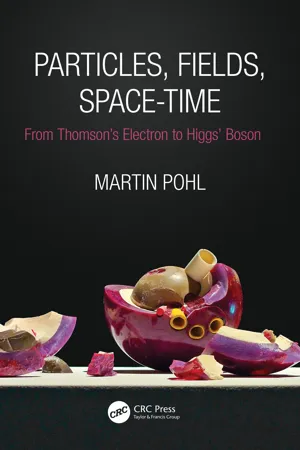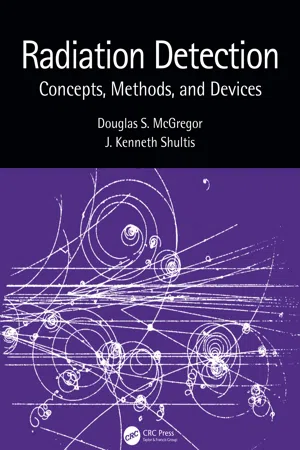Physics
Bohr Model of the Atom
The Bohr Model of the Atom, proposed by Niels Bohr in 1913, depicts the atom as a small, positively charged nucleus surrounded by orbiting electrons in specific energy levels. This model successfully explained the spectral lines of hydrogen and laid the foundation for understanding atomic structure and quantum mechanics. It was a significant advancement in the field of atomic physics.
Written by Perlego with AI-assistance
8 Key excerpts on "Bohr Model of the Atom"
Learn about this page
Index pages curate the most relevant extracts from our library of academic textbooks. They’ve been created using an in-house natural language model (NLM), each adding context and meaning to key research topics.
- eBook - ePub
- Colin Salter(Author)
- 2021(Publication Date)
- Pavilion(Publisher)
Niels Bohr
(1885–1962)
Model of the atom
When Ernest Rutherford published his inspired model of the atom in 1911, it galvanized the atomic physics community. As other scientists looked at it through the prism of their own research, it proved accurate but incomplete. One, Danish scientist Niels Bohr, saw its implications for quantum theory.M ax Planck first proposed the quantum, the minimum amount of any agent in a reaction which was required to make the reaction work, in 1900. Planck applied the idea particularly to electromagnetic radiation, a field in which Niels Bohr completed his PhD in the summer of 1911. Bohr’s research was in the electrons and magnetism of metal elements, and he had concluded that the latter could not be explained by the former alone.In September of that year Bohr travelled to England to meet the great minds of that country’s universities. He impressed Rutherford sufficiently to be invited to join him for a year in post-doctoral research at Manchester University. Bohr combined Rutherford’s ideas with Max Planck’s and proposed an atomic model in which electrons not only orbited around a neutron as Rutherford had suggested; they did so at different distances, like the planets around the Sun, and were capable of dropping from an outer orbit to an inner one by shedding a quantum of electromagnetic energy.Rutherford was one of the first to applaud the Bohr Model. It was also enthusiastically received by the younger generation of nuclear physicists, including Albert Einstein, Max Born and Enrico Fermi. The model won admirers because it explained reactions and properties which other models, even Rutherford’s, could not. Better still, it could be used to predict the outcomes of experiments yet to be conducted; and the Bohr Model formed the basis of quantum theory for the next twelve years, until the development of quantum mechanics. He was awarded the Nobel Prize for physics in 1922.Neils Bohr with Albert Einstein in the 1920s. Bohr, together with Heisenberg, had views on quantum theory that conflicted with Einstein’s own beliefs and the pair were often involved in heated debates on the subject. - eBook - ePub
Semiconductor Basics
A Qualitative, Non-mathematical Explanation of How Semiconductors Work and How They are Used
- George Domingo(Author)
- 2020(Publication Date)
- Wiley(Publisher)
Figure 1.13 ). Electrostatic forces between the proton and the electron (analogous to the gravitational forces in the solar system) keep the electrons circulating without escaping their orbit. Additionally, Bohr postulated that the electrons in orbit do not radiate any energy, so the orbits are stable. The only way to radiate or absorb any energy is for an electron to jump from one orbit to another, and that is precisely what explains the spectra of hydrogen and other elements.Niels Bohr (left) postulated the planetary model of the atom. Wolfgang Pauli (right), using quantum mechanics, proved that no two electrons in a system can have the same quantum numbers.Figure 1.12Source: Wikipedia, https://en.wikipedia.org/wiki/Niels_Bohr#/media/File:Niels_Bohr.jpg (left); Wikipedia, https://en.wikipedia.org/wiki/Wolfgang_Pauli#/media/File:Pauli.jpg (right).The Bohr planetary model of an atom has discrete and stable orbits. An electron falling from level 3 to level 2 transfers its energy to an equivalently energetic photon.Figure 1.13Since electrons are forbidden to have any energy except for the energy of a specific orbit, they have to jump from one orbit to another, like going up the stairs, one, two, or three steps at a time (not one and a half). When falling from a higher orbit to a lower one, the electron releases a fixed packet of energy in the form of a photon of a very precise frequency (remember that Einstein said light behaves like a particle with an energy related to the wavelength of the light: Eq. 1.5 ). The transition from orbit 3 to orbit 2, as I show in Figure 1.13 , results in the emission of a photon of a very precise frequency, given by the change in energy, ΔE - eBook - ePub
Particles, Fields, Space-Time
From Thomson's Electron to Higgs' Boson
- Martin Pohl(Author)
- 2020(Publication Date)
- CRC Press(Publisher)
It mainly addressed the question of mechanical stability à la Thomson, ignoring radiative instability. But it also contained first hints at his atomic model, introducing the “special hypothesis” that the kinetic energy of an electron be proportional to its revolution frequency. Bohr also thought he had a solution for the problem of periodicity in atoms, as exhibited by Mendeleev’s table [ 430 ]. The rest of the memorandum addressed simple molecules and chemical binding. He did not argue in terms of quanta, but the work of Nicholson put him on the track. In March of 1913 he sent the first part of his famous 1913 trilogy of papers [ 146, 147, 148 ] to Rutherford, in which he set out what we call today Bohr’s atomic model. It boldly left behind the classical treatment of the problem by what one can call heuristic axioms: • Not all classical orbits are available to the electron, but only those called stationary, where it does not radiate electromagnetic energy. The stationary states can be numbered by a principle quantum number n, n = 1 denotes the ground state of the atom. A specific energy E n belongs to each such state. • The electron can jump from one stationary state i to another j. This “quantum leap” is outside the realm of classical physics. When the electron undergoes this process, energy is conserved by emitting or absorbing an electromagnetic wave, with a frequency ν such that its energy, hν = E i − E j, corresponds to the energy difference between the two stationary states. It is thus not the frequency or energy of the orbiting electron, but the energy difference between the initial and the final stationary states which determines the frequency of the light. These hypotheses lead to the Rydberg formula for the Balmer series when one makes one of two additional assumptions. One hypothesis, sometimes called the third Bohr postulate, requires that in addition to the energy, also the angular momentum of the electron’s orbit comes in quanta (see Focus Box 5.4) - eBook - ePub
Radiation Detection
Concepts, Methods, and Devices
- Douglas McGregor, J. Kenneth Shultis(Authors)
- 2020(Publication Date)
- CRC Press(Publisher)
-1 , which agrees with the observed value to eight significant figures!The innermost orbits of the electron in the hydrogen atom are shown schematically in Fig. 3.11 to scale. The electronic transitions that give rise to the various emission series of spectral lines are also shown. The Bohr model, with its excellent predictive ability, quantizes the allowed electron orbits. Each allowed orbit is defined by the quantum number n introduced through Bohr’s second postulate, a postulate whose justification is that the resulting predicted emission spectrum for hydrogen is in amazing agreement with the observation.Figure 3.11. Bohr orbits for the hydrogen atom showing the deexcitation transitions that are responsible for the various spectral series observed experimentally. After Kaplan [1963].3.3.5Extension of the Bohr Theory: Elliptic OrbitsThe Bohr theory was very successful in predicting with great accuracy the wavelengths of the spectral lines in hydrogen and singly ionized helium. Shortly after Bohr published his model of the atom, there was a significant improvement in spectroscopic resolution. Refined spectroscopic analysis showed that the spectral lines were not simple, but consisted of a number of lines very close together, a so-called fine structure. In terms of energy levels, the existence of a fine structure means that instead of a single electron energy level for each quantum number n, there are actually a number of energy levels lying close to one another. Sommerfeld partly succeeded in explaining some of the lines in hydrogen and singly ionized helium by postulating elliptic orbits as well as circular orbits (see Fig. 3.12 - Kevin Reel, Derrick C. Wood, Scott A. Best(Authors)
- 2014(Publication Date)
- Research & Education Association(Publisher)
Figure 5.1. Thompson Model of the AtomMillikan
Robert Millikan performed research on the electron. He is best known for his oil-drop experiment where he calculated the charge of an electron based upon a mass-to-charge ratio.Rutherford
Ernest Rutherford was a contemporary of J. J. Thompson. Rutherford is known for his gold foil experiment where positively charged alpha particles were fired at a thin sheet of gold foil. Rutherford measured the resulting scatter patterns of the alpha particles after they were fired into the foil. He found that most of the alpha particles moved right through the foil, or were deflected slightly. However, some alpha particles were deflected at large angles, as though they had collided with a heavier, charged object and bounced back. Rutherford concluded that atoms are mostly empty space, but they contain a massive, positively charged center (nucleus). This directly countered Thompson’s “plum pudding” model.Planck
Max Planck determined that electromagnetic energy is quantized, or composed of discrete bundles of energy.Bohr
Niels Bohr applied the idea of quantized energy to show that electrons exist around the nucleus at a fixed radius. Electrons with higher potential energy exist farther from the nucleus. Bohr’s model (see Figure 5.2 ) eloquently described the absorption and emission of photons by atoms, linking energy changes to electron transitions. However, the Bohr model is only accurate for the one electron system of hydrogen.Figure 5.2. Bohr’s Modelde Broglie
Louis de Broglie identified the wave characteristics of matter by combining Einstein’s relationship between mass and energy (E = mc2 ) and the relationship between velocity and the wavelength of light (E = hv- eBook - ePub
- Jeffrey Gaffney, Nancy Marley(Authors)
- 2017(Publication Date)
- Elsevier(Publisher)
The electrons cannot exist between orbits. There are a series of these stable orbits of different energies and at different distances from the nucleus. The orbit closest to the nucleus is of lowest energy, while the one farthest from the nucleus is of highest energy. This arrangement results in the energy of the electrons being restricted to certain allowed values. This restriction of electrons to a limited number of possible energy values is known as being quantized. The allowed orbits are each designated by a positive integer n called the principal quantum number. The value of n is equal to 1 for the orbit closest to the nucleus and increases with distance from the nucleus as shown in Fig. 2.4. As n increases and the electrons occupy orbits further from the nucleus, the energy of the electron increases. So each orbit is also known as the energy level of the electron. Fig. 2.4 Neils Bohr's model of the atom with electrons confined to discrete stable orbitals. Case Study: The Emission Spectrum of Hydrogen When hydrogen gas is exposed to an electric current or heated to high temperatures, it emits light that appears blue to the human eye. However, when this light is separated into its component wavelengths by passing it through a prism, it is found that it is actually composed of several discrete lines at different wavelengths with only darkness in between. This type of light spectrum is called a line emission spectrum. The line emission spectrum of hydrogen is shown in Fig. 2.5. Since the visible spectrum is from 390 to 700 nm, only four of these lines can be seen without using infrared and ultraviolet detectors. These visible lines appear at 656 (red), 486 (blue green), 434 (blue violet), and 410 (violet). Because these lines could be detected by the human eye, they were the first to be discovered. They were called the Balmer series after Johann Balmer who first predicted their existence - eBook - ePub
Chemistry
Concepts and Problems, A Self-Teaching Guide
- Richard Post, Chad Snyder, Clifford C. Houk(Authors)
- 2020(Publication Date)
- Jossey-Bass(Publisher)
Now we are going to look at a model of the atom that helps chemists explain many properties and reactions. Essentially, we will try to develop in your mind a picture of the arrangement of the electrons in an atom and how this arrangement relates to the location of the atom in the periodic table. Later, we will use this arrangement in discussing chemical bonding, chemical reactions, and chemical properties.QUANTUM ATOMIC MODEL
The model we discuss has evolved from the study of quantum mechanics (a theoretical mathematical approach to the study of atomic and molecular structure). We do not attempt an in-depth presentation here. Instead, we present some of the basic concepts so you may use them later in this book or build upon them in other chemistry courses.Keep in mind that we are studying the basic model of a very complex theory. A good way to help you remember the model is to compare it to an apartment building. An apartment building has different floors, different apartments on each floor, and different rooms within each apartment.We can look upon the electrons of an atom as rather peculiar apartment dwellers. Electrons prefer the floor closest to the ground and the smallest apartments. Electrons also prefer to live one to a room until each room in an apartment has one occupant. The electrons will then pair up until each room has two. Each room in the apartment can hold only two electrons.Apartment buildings may have several floors. The model we discuss has several floors, but only the first seven floors will be occupied. All the electrons of the elements known today will fit within seven floors of the building. Additional floors are available but will be occupied only in special cases.The floors in the apartment building are called shells in the electron model and are numbered 1 through 7. According to what you have just read, what shell will be occupied first by electrons? _________Answer: shell 1 (the first floor)Each shell (or floor) in the model has one or more apartments, which are called subshells. These subshells are apartments of four sizes: s, p, d, and f. An s subshell (apartment) has only a single room. A p subshell has three rooms. A d subshell has five rooms, while an f subshell has seven rooms. An s - eBook - ePub
- Atef Korchef(Author)
- 2022(Publication Date)
- CRC Press(Publisher)
successes. For example: It succeeded in explaining the emission spectrum of the hydrogen atom. Furthermore, it succeeded in explaining the spectral line series of species that, like hydrogen atom, have only one electron in the valence shell (“hydrogenic species”), such as He + and Li 2+. For the hydrogenic species: Δ E a t o m = h C λ = − 2. 1 8 × 1 0 − 1 8 × Z 2 1 n f i n a l 2 − 1 n i n i t i a l 2 where Z is the atomic number of the hydrogenic species. It introduced the concept of “allowed orbits” which was developed further with Schrödinger’s theory. It was an important contribution to the model of the atom. However, the Bohr model also has shown many limitations: It could not explain why orbits were allowed. It explained the emission spectrum of the hydrogen atom and atoms or ions that have only one electron in the valence shell (hydrogenic species) but did not always explain those of other elements. It could not explain the splitting of the spectral lines in the presence of a magnetic field (the so-called Zeeman effect) (Figure. 6.5). FIGURE 6.5 Zeeman effect Get Smart How to calculate the energy and the wavelength of a line in the spectral line series of atoms of hydrogen and hydrogenic species? The emission spectrum of a hydrogen atom is discontinuous and is divided into spectral line series. The wavelength of each line is given by the Rydberg formula: 1 λ = R × 1 n 1 2 − 1 n 2 2 or Δ E = h × C λ = h × C × R × 1 n 1 2 − 1 n 2 2 where h = 6.63 × 10 −34 J s, R = 1.09677 × 10 7 m −1 and C = 3.00 × 10 8 m. s −1 Δ E = 6.63 × 10 − 34 × 3.00 × 10 8 × 1.09677 × 10 7 × 1 n 1 2 − 1 n 2 2 = 2.18 × 10 − 18 1 n 1 2 − 1 n 2 2 and n 2 > n 1. When. n 2 < n 1, 1 λ = R × 1 n 2 2 − 1 n 1 2 and Δ E = 2.18 × 10 − 18 1 n 2 2 − 1 n 1 2 For the hydrogenic species: 1 λ = R × Z 2 1 n 1 2 − 1 n 2 2 and Δ E = 2.18 × 10 − 18 × Z 2 1 n 1 2 − 1 n 2 2 where Z is the atomic number of the hydrogenic species and







